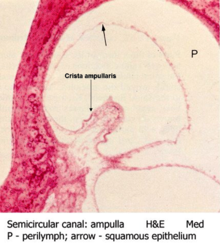- Crista ampullaris
-
Crista ampullaris The crista ampullaris is the sensory organ of rotation located in the semicircular canal of the inner ear. The function of the crista ampullaris is to sense angular acceleration and deceleration.
Background
The inner ear comprises two specialized regions of the membranous labyrinth: the saccule and the utricle.
- The saccule gives rise to the cochlear duct, which is involved in the special sense hearing.
- The utricle gives rise to the semicircular canals, which is involved in "equilibrium/balance".
The Semicircular canals are filled with perilymph, and also contain an inner membranous sleeve that form semicircular ducts. The semicircular ducts are filled with endolymph, and contain the crista ampullaris. The receptor cells located in the semicircular ducts are innervated by the eighth cranial nerve, aka vestibulocochlear nerve (more specifically the vestibular portion).
The crista ampullaris itself is a cone-shaped structure, covered in receptor cells called "hair cells". Covering the crista ampullaris is a gelatinous mass called the cupula. Upon angular acceleration (rotation), the endolymph within the semicircular duct deflects the cupula against the hair cells of the crista ampullaris. The hair cells respond by stimulating neurons that innervate them.
External links
- http://faculty.une.edu/com/abell/histo/CristaAmp.jpg
- http://www.kumc.edu/instruction/medicine/anatomy/histoweb/eye_ear/ear04.htm
- http://www.anatomyatlases.org/MicroscopicAnatomy/Section16/Plate16314.shtml
- http://www.med.uiuc.edu/histo/small/atlas/objects/1296.htm
- http://education.vetmed.vt.edu/Curriculum/VM8054/Labs/Lab11/Ear/EXAMPLES/Excrista.htm

This anatomy article is a stub. You can help Wikipedia by expanding it.

